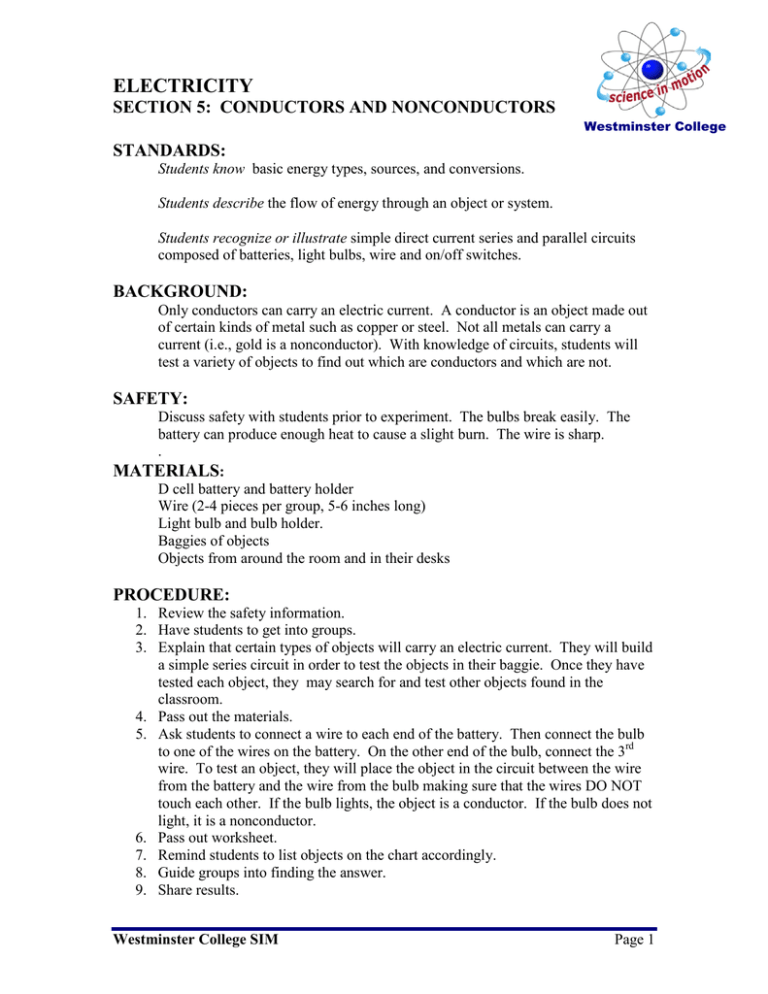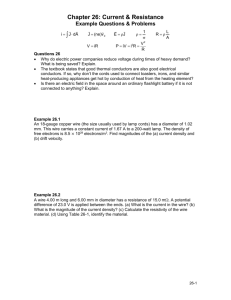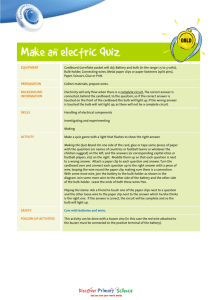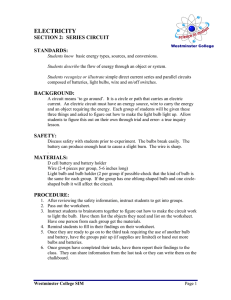ELECTRICITY SECTION 5: CONDUCTORS AND NONCONDUCTORS STANDARDS:
advertisement

ELECTRICITY SECTION 5: CONDUCTORS AND NONCONDUCTORS Westminster College STANDARDS: Students know basic energy types, sources, and conversions. Students describe the flow of energy through an object or system. Students recognize or illustrate simple direct current series and parallel circuits composed of batteries, light bulbs, wire and on/off switches. BACKGROUND: Only conductors can carry an electric current. A conductor is an object made out of certain kinds of metal such as copper or steel. Not all metals can carry a current (i.e., gold is a nonconductor). With knowledge of circuits, students will test a variety of objects to find out which are conductors and which are not. SAFETY: Discuss safety with students prior to experiment. The bulbs break easily. The battery can produce enough heat to cause a slight burn. The wire is sharp. . MATERIALS: D cell battery and battery holder Wire (2-4 pieces per group, 5-6 inches long) Light bulb and bulb holder. Baggies of objects Objects from around the room and in their desks PROCEDURE: 1. Review the safety information. 2. Have students to get into groups. 3. Explain that certain types of objects will carry an electric current. They will build a simple series circuit in order to test the objects in their baggie. Once they have tested each object, they may search for and test other objects found in the classroom. 4. Pass out the materials. 5. Ask students to connect a wire to each end of the battery. Then connect the bulb to one of the wires on the battery. On the other end of the bulb, connect the 3rd wire. To test an object, they will place the object in the circuit between the wire from the battery and the wire from the bulb making sure that the wires DO NOT touch each other. If the bulb lights, the object is a conductor. If the bulb does not light, it is a nonconductor. 6. Pass out worksheet. 7. Remind students to list objects on the chart accordingly. 8. Guide groups into finding the answer. 9. Share results. Westminster College SIM Page 1 CONDUCTORS AND NONCONDUCTORS CONCLUSION: Discuss results. Have students make observations and conclusions about the objects that were nonconductors. Discuss how wire is made of copper because it is flexible and can carry an electric current. Explain how wire is wrapped in rubber/plastic as a safety precaution, but if you were to remove it, you would see the wire (you can use the wire cutters to strip the plastic coated wire to display). Westminster College SIM Page 2 CONDUCTORS AND NONCONDUCTORS Westminster College SIM Page 3 CONDUCTORS AND NONCONDUCTORS Westminster College SIM Page 4







